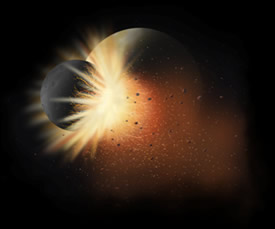Another Moon-forming collision?
A recent discovery from the Spitzer Space Telescope may yield new insight into the origin of our own Moon.

A recent discovery from the Spitzer Space Telescope may yield new insight into the origin of our own Moon. Although this discovery was in the news some time ago, the advent of the Augustine report and the LCROSS mission results have eclipsed it.
The Spitzer Telescope found evidence for a planetary collision around the star HD 172555, about 100 light-years away from our Solar System. This evidence was a heat signature associated with spectral evidence for silicon monoxide gas (a fairly rare substance) and glassy silica dioxide, a common form of silica glass found associated with volcanoes on Earth. These substances were found associated with a large cloud of silicate debris: the ground-up and pulverized parts of the outer portions of two rocky planets. The evidence suggests that two planets collided with each other at relative speeds exceeding 10 kilometers per second.
This set of circumstances is (more or less) the same that we expect in the aftermath of the currently favored model for the origin of our own Moon. Traditionally, Earth’s Moon was considered to have formed in one of three different ways. One model called for Earth and Moon to accrete (assemble) from a collection of small bodies simultaneously; with great imagination, this model was called “co-accretion.” The second idea called for the Moon to form somewhere else in the Solar System and then be “captured” into orbit by a near-miss encounter with the Earth. The last model of “fission” suggested that the Moon was ripped from the body of the Earth at a very early stage of our history when it was molten (or nearly so) and spinning very quickly. This spun-off piece of molten slag then became our Moon.
Although each of these models had its proponents in the days before and immediately after the Apollo missions, none of them seem to simultaneously satisfy all the constraints those program results provided. The general composition of the Moon is very similar to the mantle of the Earth, suggesting some variant of the fission model might be the answer. The problem with fission was its physical implausibility, as the early Earth was not like binary stars cited as analogs by the model’s proponents. The near-identical oxygen isotopes of Earth and Moon indicated that co-accretion might be correct, but why would such planetary formation create two different objects (Earth and Moon) instead of a single body? Capture was an attractive way of explaining the subtle differences between Earth and Moon, but not their similarities and it was not an easy model to reconcile dynamically with the Moon’s orbital properties.
The advent of the “Giant Impact” model of lunar origin supposedly severed this Gordian Knot of lunar origin. Although first proposed in the mid-1970’s, it seemed to emerge fully grown from the forehead of Zeus at the 1985 Origin of the Moon conference in Kona, Hawaii. In one fell swoop, the “big whack” explained all the salient features of the Earth-Moon system, including its oxygen isotopes (both Earth and proto-Moon formed at the same position near the Sun), its depletion in volatiles (such a large impact would vaporize the planets’ mantles and this material would be depleted in volatiles), and the high degree of angular momentum in the Earth-Moon system (an off-center impact would speed up the Earth’s rotation while the Moon was spun off into orbit around it).
Although many scientists embraced the Giant Impact model, a few dissidents remain. Much of the model’s attraction stems from its apparent ability to explain any particular fact about or constraint on the Moon. Lack of volatiles troubling? No problem – the big whack would drive them away. High spin rates on the early Earth? The impact hit off-center. Moon’s bulk composition like the Earth’s mantle? The Moon came from the Earth’s mantle. Is it too unlike the Earth’s mantle? No problem – it comes mostly from the mantle of the (now destroyed) impactor planet. In other words, the model is largely unconstrained and elastic enough to fit any fact or observation.
Scientists tend to be uncomfortable with such models; not only do they lack predictive power, they seem too much like “Just-So” stories. However, finding something unexpected that matches the predictions of a model tend to give that model veracity and “completes” the jigsaw puzzle. The new Spitzer findings might well be that missing piece of the puzzle. They suggest that planetary collisions do happen (we didn’t really doubt that, but it’s nice to have a concrete example). The presence of silicon monoxide gas indicates very high temperature, non-equillibrium processes – exactly what would be expected from a giant impact.
We may well find systems in various stages of evolution as we continue to observe the nearer stars and examine their planetary systems. Having oither examples of multiple planetary systems allows us to “field check” our suppositions about the history of our own Solar System. Some of the apparently contrived “Just So” stories may just be correct.
/https://tf-cmsv2-smithsonianmag-media.s3.amazonaws.com/accounts/headshot/blog_headshot_spudis-300x300.jpg)
/https://tf-cmsv2-smithsonianmag-media.s3.amazonaws.com/accounts/headshot/blog_headshot_spudis-300x300.jpg)